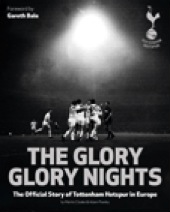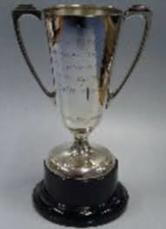 We look back at another competition that Spurs have played in over the years. This time it’s a competition that was born out of disaster and died from apathy. It did however give one Tottenham legend a swansong at the Lane as we reached the semi final. The competition, when it is remembered, is more often referred to as the title the sponsors called it, The Super Screen Cup. Let us look back at some events from the 1985 /86 season. The competition was born from the UEFA ban on English clubs competing in European competition after the Liverpool fans behaviour at the Heysel Stadium disaster in 1985 in which 39 Juventus fans died when a wall collapsed. This was the latest in a number of incidents involving English fans and UEFA introduced the ban which many expected was coming to rid itself of what was popularly known as ‘the English disease.’ Although the English shouldn’t be given all the blame The Football League came up with the idea that the six clubs who would have competed in Europe take part in a domestic competition as some kind of financial compensation. Everton who would have been in the old European Cup against Barcelona and Bayern Munich, found themselves instead playing Norwich. It would be an understatement to say the competition was not embraced by the fans (or the clubs) as they already had two domestic trophies to compete for. This was also at a time when the clubs were in dispute with television companies anyway over payments. It may seem strange to us now but football did not trust TV and thought it would be the death of the live game. What little football was shown at that time now disappeared from our screens until around midway through the season. Basically not a good time to be a football fan. There was talk regarding inviting Scottish clubs to take part but this failed to happen. 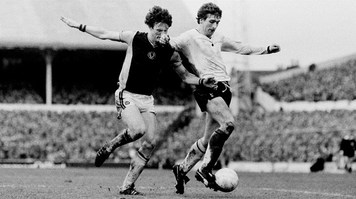 Attempts at finding a sponsor for the competition failed. The Guardian reported that one brewing giant was keen on sponsoring the event but then decided being connected to a competition born out of a disaster where alcohol had been part of the catalyst wasn’t a good idea. Only at the last moment was a deal struck with the Cable TV company that gave the competition its more popular name. left - Mark Falco The six teams were drawn into two groups of three. Each team would play each other twice and the top two in each group would go to the semi-final’s. Tottenham’s group opened with Liverpool beating Southampton. Then in September Southampton came to White Hart Lane and before the club’s lowest gate in 39 years, just eleven and a half thousand, Spurs won 2-1. Both our goals coming from Mark Falco. Peter Shreeves the manager described the attendance as ‘it was a little disappointing.’ 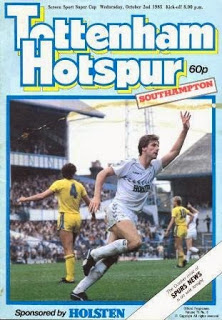 Southampton and Liverpool then drew on the South Coast. Spurs traveled to Liverpool and lost 0-2. The week before Christmas Spurs visited Southampton and won 3-1. The Spurs scorers were Falco, Clive Allen and Leaworthy. The last game in the section was Liverpool at White Hart Lane. This time Spurs drew an even smaller gate of 10,078. All the goals came in the second half as the visitors won 0-3. The game is worthy of mention for one reason. Pat Jennings (at the age of 41) had returned home after eight years and had signed for Spurs to get himself fit for that summers World Cup. This was his only game in this second spell at Tottenham and therefore his last for the club. The other group had opened with Manchester United hosting Everton in a 2-4 defeat. Rumour has it the two Merseyside teams were kept apart to increase interest. Strangely the United chairman at the time wrote in the programme he hoped the competition would only last one season. A reference to the hope the European ban would be lifted, it would in fact last five years. Everton’s next game was away to Norwich. Howard Kendall their manager is reported as giving a team talk that finished, ‘this is all a waste of time, get out there.’ Norwich would qualify for the semi final when they drew with Manchester United’s reserve side in the last group game. The Guardian’s report states the United side gave the ball away with depressing regularity and gave the impression they didn’t care.’ 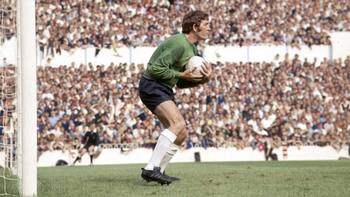 The semi final brought Everton (fielding almost a reserve side) to the Lane in the first leg. It also brought even less supporters, a massive 7,548 ‘crammed’ on to the terraces to watch a 0- 0 draw. The score line reflecting the interest of all concerned. The return six weeks later before a massive 12,008 saw Everton take the lead before Falco pulled us level. That’s how it ended and so to extra time where the home team scored twice. Tottenham were out but Mark Falco finished the second highest scorer in the competition. right - Pat Jennings The other semi saw Liverpool and Norwich also draw the first leg. Fixture congestion meant that the second leg of that tie would not be played for three months before Liverpool beat Norwich.
The FA had insisted the season be finished on time so they could prepare for the World Cup that summer so the final was held over until the following season. Just under a year after the competition started the two Mersey side teams met in the two legged final, they did not even get a Wembley day out. Everton partly through apathy and party because of injuries fielded a very weaken side as Liverpool won over the two legs 7-2. The myth says that after the trophy was presented and as Liverpool left the field they gave the trophy to a Everton ball boy. I can find no evidence of this actually happening but it does tend to sum up everyone’s feelings towards the event. The competition was cancelled after the one season. Whilst all the clubs failed to engage the supporters interest the Tottenham fans had a poor season to look back on. Apart from the 42 game league season when we finished tenth. The FA Cup saw us need replays to get past both Oxford and Notts County before we were eliminated by Everton. The Milk (League) Cup saw as beat Leyton Orient over two legs and Wimbledon before losing out to Portsmouth, a tie that went to three games. Catch up with a look at Tottenham and a few other competitions over the years - The Charity Shield, The World Club Championship, The InterToto Cup, The Coronation Cup (Hotspur Towers 19), The Inter-Cities Fairs Cup (Hotspur Towers 12), The Anglo-Scottish Floodlight Cup, FA Youth Cup (Hotspur Towers 34), Via the blog page. COYS Keith Harrison. t- Keith 16024542 f- peter shearman (old non de plume) View Full Bio
0 Comments
Leave a Reply. |
Features
Flying Down to Rio History of T.H.F.C. Tribute to Bill Nicholson Talking Tottenham Early Legends The Road to Turin International Connections Hotspur Towers Most Read Articles
The 100 Year War Interview with Marina Sirtis A Long Dark Shadow By Royal Appointment School Report: An Insight into the Younger Eric Dier Dear Jimmy All Change At Spurs Hotspur Towers History Of THFC: Part 1 Passage to India: Rohan Rickets Thanks For The Memories Our Tommy Carroll The AVB Files: Part1 The Lilywhites You The Jury The Hand Of Hugo Connection - Argentina Creating a Reputation One Hotspur Archives
August 2018
Categories
All
|
 RSS Feed
RSS Feed
